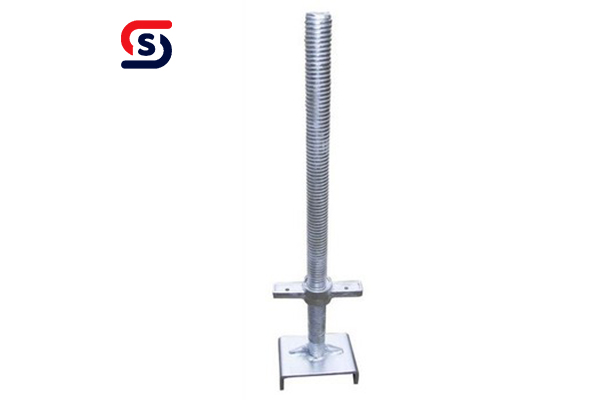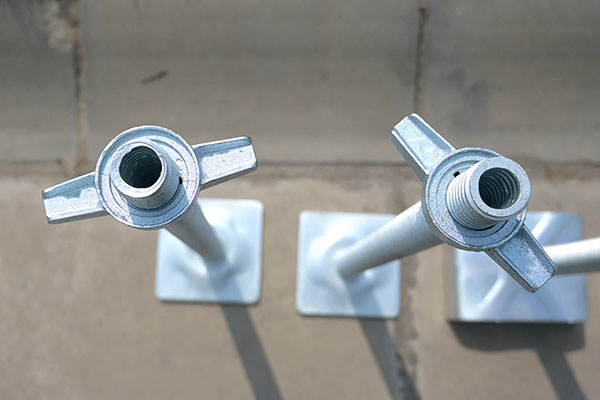How Does a Scaffold Screw Jack Work? A Comprehensive Guide
Scaffolding is an essential component in construction, providing workers with safe and stable platforms for tasks at height. Among the many elements that ensure the security and adjustability of scaffolding systems, the scaffold screw jack plays a crucial role. Understanding how a scaffold screw jack works will give you insight into the importance of this small yet powerful device in maintaining the stability and functionality of scaffolding structures.

What is a Scaffold Screw Jack?
A scaffold screw jack, also known as a leveling jack, is a mechanical device used to adjust the height of scaffold frames or platforms. This component is typically made of galvanized steel or other durable materials to withstand heavy loads and outdoor conditions. The jack is threaded with a screw, which allows it to be raised or lowered by turning a nut or handle at the top.
Scaffold screw jacks are placed at the base of scaffold legs or inside the scaffolding frame to adjust the height and level of the scaffold on uneven ground. They help distribute the weight of the scaffold evenly and prevent instability.
Key Components of a Scaffold Screw Jack
- Threaded Shaft: The main part of the screw jack, which is a long steel rod with spiral threading. This threading allows the nut or handle to rotate and adjust the height.
- Base Plate: Attached to the bottom of the screw jack, the base plate distributes the weight evenly across the ground or a foundation surface. The base plate helps prevent the scaffold from sinking into soft surfaces or losing balance.
- Adjusting Nut: The nut, sometimes referred to as a collar or wingnut, is the part that rotates around the threaded shaft. By turning this nut, the height of the scaffold leg is adjusted up or down.
- Handle or T-Bar: In some scaffold screw jacks, a handle or T-bar is used to turn the nut, making it easier to raise or lower the scaffold’s height.

How Does a Scaffold Screw Jack Work?
The function of a scaffold screw jack is simple but highly effective. Here’s how it works step by step:
- Placement: Scaffold screw jacks are placed under the legs or frames of a scaffold. On uneven or sloped surfaces, it’s essential to use screw jacks to keep the scaffold level and stable.
- Height Adjustment: To raise or lower the scaffold, workers turn the adjusting nut or handle. As the nut rotates along the threaded shaft, the scaffold leg attached to the screw jack will move up or down, depending on the direction of rotation.
- Leveling: Once the scaffold legs have been adjusted to the desired height, the screw jack ensures that the scaffold is level. This prevents wobbling or instability, especially on uneven surfaces like gravel, dirt, or sloped concrete.
- Locking the Height: After adjusting the height, the screw jack can be locked into place by securing the nut. Some systems also have additional locking mechanisms for extra safety.
- Load Distribution: The base plate of the screw jack spreads the weight of the scaffold across a larger area, preventing the scaffold legs from sinking into soft ground or causing damage to surfaces like asphalt or paving.
Why Are Scaffold Screw Jacks Important?
- Enhanced Stability: A stable scaffold is a safe scaffold. Screw jacks provide the ability to adjust the height of the scaffold on uneven surfaces, ensuring that the structure remains steady during use.
- Improved Safety: By leveling the scaffold, screw jacks reduce the risk of tipping or collapsing. This is especially important on construction sites where uneven terrain is common.
- Customization for Any Site: Whether you’re working on a flat surface or a sloped construction site, screw jacks allow you to adjust the height of the scaffold to fit the specific needs of the job.
- Increased Load Capacity: High-quality screw jacks are designed to bear heavy loads, making them suitable for use in large-scale construction projects where weight distribution is critical.

Maintenance Tips for Scaffold Screw Jacks
- Regular Inspection: Inspect screw jacks regularly for signs of wear, rust, or damage. Worn-out threads or bent shafts can compromise the safety of the scaffold.
- Lubrication: The threaded shaft should be lubricated to ensure smooth movement and prevent rusting, especially in outdoor environments.
- Proper Storage: When not in use, store screw jacks in a dry area to prevent corrosion.
Conclusion
A scaffold screw jack may be a small component in the overall scaffolding system, but its role is vital. By allowing precise height adjustments and ensuring a level and stable base, screw jacks help create safer and more adaptable scaffolding structures. Whether you’re working on a construction site with uneven terrain or need to fine-tune scaffold height, understanding how a scaffold screw jack works can significantly enhance your ability to create secure and efficient working environments.
When setting up scaffolding for your next project, don’t overlook the importance of properly installing and maintaining your scaffold screw jacks to ensure the safety of your crew.
